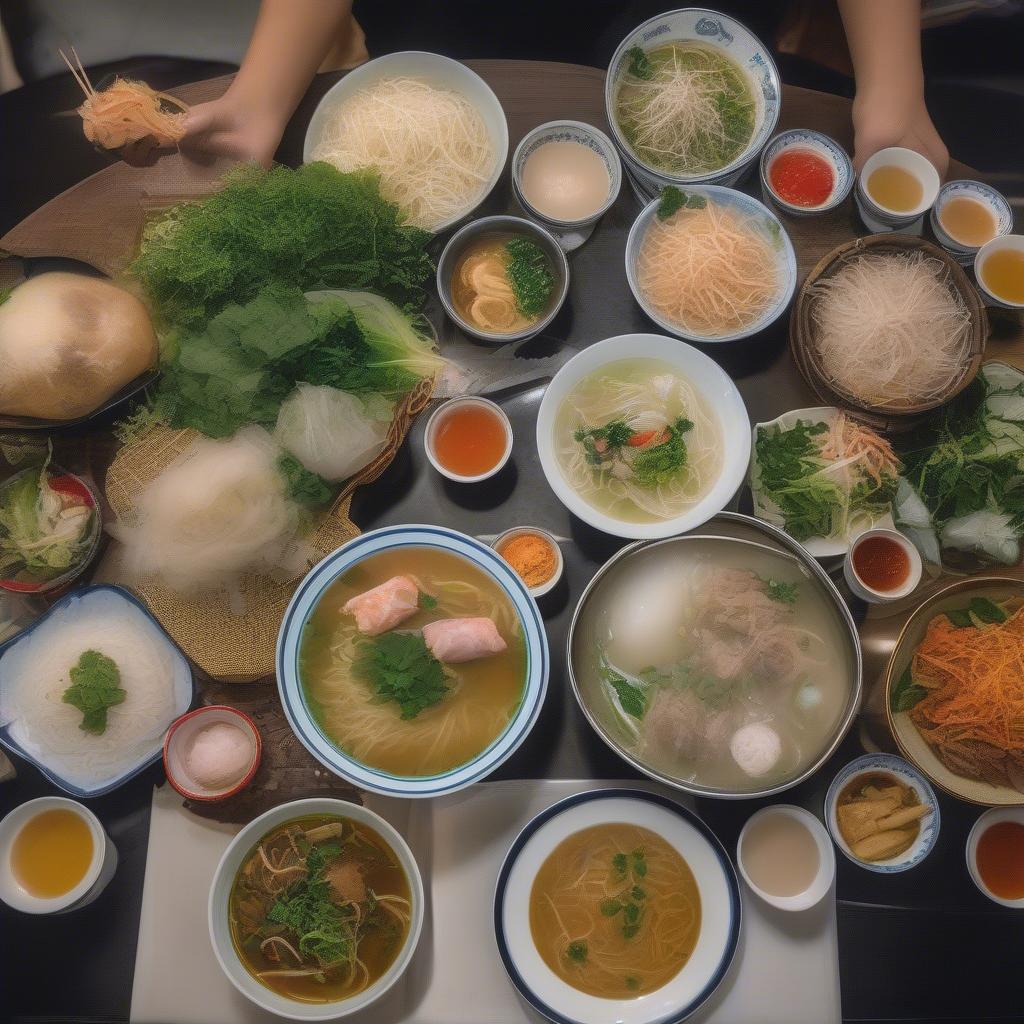
Banh cuon, a delicate steamed rice roll, is a beloved staple in Vietnamese cuisine. This seemingly simple dish is surprisingly complex, requiring skill and patience to master. How to make traditional banh cuon is a question many food enthusiasts ask, eager to recreate the authentic flavors at home. While achieving the same airy texture and delicate flavor as street vendors in Vietnam might take practice, the journey itself is a rewarding culinary adventure. At Com Com Restaurant in London, we’ve perfected the art of banh cuon, offering a taste of Vietnam in every bite. But for those who want to try their hand at making it, this guide will walk you through the process.
Table Content:
- The Origins of Banh Cuon and Com Com Restaurant’s Connection
- Ingredients and Tools You’ll Need for Authentic Banh Cuon
- Experiencing the Art of Banh Cuon at Com Com Restaurant
- Tips and Variations for Banh Cuon Perfection
- Nutritional Value and Health Benefits
- Pairing Banh Cuon for a Complete Vietnamese Meal
- Conclusion
The Origins of Banh Cuon and Com Com Restaurant’s Connection
Banh cuon has a rich history, believed to have originated in Northern Vietnam. The name itself, “rolled cake,” describes the process of steaming a thin layer of fermented rice batter on a cloth-covered pot, then carefully rolling it with savory fillings. Com Com Restaurant, deeply rooted in Vietnamese culinary traditions, honors this heritage by serving banh cuon made with the finest ingredients and time-honored techniques. We believe that food is a story, and banh cuon tells a tale of generations of Vietnamese cooks, their dedication to quality, and their love for sharing their culinary treasures.
 Steaming banh cuon batter on a cloth-covered pot
Steaming banh cuon batter on a cloth-covered pot
Ingredients and Tools You’ll Need for Authentic Banh Cuon
Making banh cuon requires specific ingredients and tools, some of which may require a trip to a specialized Asian grocery store. The key is the rice batter, typically made with a blend of rice flour, tapioca starch, and water, fermented for a slightly sour tang. At Com Com Restaurant, we source our ingredients carefully to ensure the most authentic flavor. To embark on your own banh cuon journey, gather the following: rice flour, tapioca starch, water, ground pork, minced wood ear mushrooms, dried shallots, fish sauce, vegetable oil, and dipping sauce ingredients (fish sauce, sugar, lime juice, chili). You’ll also need a steamer pot, a thin cloth for steaming, a spatula, and a large, flat surface for rolling.
 Ingredients and tools for making banh cuon
Ingredients and tools for making banh cuon
Experiencing the Art of Banh Cuon at Com Com Restaurant
While making banh cuon at home can be a fulfilling experience, sometimes you crave the convenience and expertise of a restaurant. Com Com Restaurant offers the perfect solution. Located in the heart of Battersea, London, Com Com provides an authentic Vietnamese dining experience. Our chefs, masters of their craft, meticulously prepare each dish, including the delicate banh cuon, ensuring an unforgettable culinary journey. Visit us at 183-185 Battersea Park Rd, London SW11 4LB, UK, open daily from 12:00 PM to 10:00 PM. Or experience the taste of Vietnam in the comfort of your own home with our convenient delivery service. Just like our Vietnamese Fried Rice Cake with Egg (Bot Chien Trung) Recipe, our banh cuon embodies the fresh, vibrant flavors of Vietnamese street food.
Tips and Variations for Banh Cuon Perfection
Once you’ve mastered the basic banh cuon recipe, there are endless possibilities for customization. Experiment with different fillings, such as shredded chicken, prawns, or tofu. You can also add herbs like cilantro and mint for a refreshing twist. For a vegetarian option, simply omit the meat and enhance the flavor with more mushrooms and vegetables. Similar to our How to Make Vietnamese Spicy Noodles (Bun Bo Hue), adjusting the ingredients slightly can create a completely new culinary experience.
Nutritional Value and Health Benefits
Banh cuon, especially the vegetarian versions, offers a healthy and balanced meal option. The rice rolls are a good source of carbohydrates, while the fillings provide protein and essential nutrients. At Com Com Restaurant, we strive to use fresh, high-quality ingredients, ensuring that our banh cuon is not only delicious but also nutritious. For those interested in the health benefits of Vietnamese cuisine, our Why Com Com Restaurant is a Must-Visit for Vietnamese Food Lovers blog post provides further insights.
Pairing Banh Cuon for a Complete Vietnamese Meal
Banh cuon is often enjoyed with a variety of accompaniments, enhancing the flavors and creating a balanced meal. Fresh herbs, like cilantro, mint, and basil, add a refreshing touch. A side of nuoc cham, the quintessential Vietnamese dipping sauce, is a must. You can also add fried shallots for a crispy element and a touch of sweetness. At Com Com Restaurant, we recommend trying our banh cuon with a refreshing cabbage salad or a side of goi cuon (fresh spring rolls). For a deeper dive into our menu, check out our Com Com London Review: Fresh, Flavorful, and Authentic Vietnamese Food.
 Banh cuon served with fresh herbs and nuoc cham
Banh cuon served with fresh herbs and nuoc cham
Conclusion
Banh cuon, a cornerstone of Vietnamese cuisine, is more than just a dish; it’s an experience. Whether you choose to embark on the rewarding journey of making it yourself or savor the expertly prepared banh cuon at Com Com Restaurant, we hope this guide has deepened your appreciation for this culinary gem. Come experience the authentic flavors of Vietnam at Com Com. We look forward to welcoming you! For those seeking other authentic Vietnamese dishes, check out What Makes Com Com London Stand Out for Vietnamese Food?.

